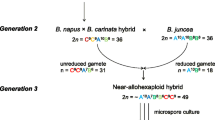Monoploids in Zea mays L. occur spontaneously among individual diploid seedlings. Plants with the gametic chromosome number have also been detected among members of multiple seedlings of maize and numerous other species of angiosperms. Previous reports disclosed that Xirradiation of the pollen successfully stimulated reduced parthenogenesis in some other angiosperms, but the results of X-ray treatment were inconclusive in maize. Therefore, a tester stock of maize homozygous for lg land gl l was crossed with pollen from inbred CI3A, carrying the dominant alleles. The pollen was exposed to 0, 1000, 2000, and 4000r units of X rays. chromosome counts were made from root tips of plants exhibiting both recessive phenotypes to establish the frequencies of monoploids in the control and X1 populations.
Monoploids were more abundant among the individual seedlings from crosses with untreated pollen than in the X1 populations. X irradiation of the pollen is not a feasible method for the induction of monoploids in maize. The X-ray treatments greatly increased the frequency of multiple seedlings, and deficiencies were numerous among them. The members of a set of multiple seedlings were always genetically identical, and no monoploid members occurred. It is concluded that the induced deficiencies caused atypical development resulting in zygotic or embryonic cleavage.
Similar content being viewed by others
References
Blakeslee, A. F., J. Belling, M. E. Farnham & A. D. Bergner (1922). A haploid mutant in the Jimson weed, Datura stramonium. Science 55: 646–647.
Campos, F. F. & D. T. Morgan, Jr. (1960). Genetic control of haploidy in Capsicum frutescens L. following crosses with untreated and X-rayed pollen. Cytologia 25: 362–372.
Chase, S. S. (1949). Monoploid frequencies in a commercial double cross hybrid maize and in its component single cross hybrids and inbred lines. Genetics 34: 328–332.
Chase, S. S. (1952). Monoploids in maize. In: J. W. Gowen, Ed., Heterosis, pp. 389–399. Iowa State College Press, Ames.
Chase, S. S. (1963). Androgenesis-its use for transfer of maize cytoplasm. J. Hered. 54: 152–158.
Goodsell, S. F. (1961). Male Sterility in corn by androgenesis. Crop Sci. 1: 227–228.
Ivanov, M. A. (1938). Experimental production of haploids in Nicotiana rustica L. Genetica 20: 295–397.
Magoon, M. L. & K. R. Khanna (1963). Haploids. Caryologia 16: 191–235.
Maheshwari, P. (1950). An introduction to the embryology of angiosperms. McGraw-Hill, New York.
Morgan, D. T., Jr. & R. D. Rappleye (1951). Polyembryony in maize and lily. J. Hered. 42: 90–93.
Randolph, L. F. (1940). Card mounts for handling root tips in the paraffin method. Stain Techn. 15: 45–48.
Sarkar, K. R. & E. H. Coe, Jr. (1966). A genetic analysis of the origin of maternal haploids in maize. Genetics 54: 453–464.
Stadler, L. J. (1931). The experimental modification of heredity in crop plants I. Induced chromosomal irregularities. Scient. Agric. 11: 557–572.
Webber, J. M. (1940). Polyembryony. Bot. Rev. 6: 575–598.
Author information
Authors and Affiliations
Additional information
Scientific Article No. A2070, Contribution No. 5023 of the Maryland Agricultural Experiment Station, Department of Botany.
Rights and permissions
About this article
Cite this article
Morgan, D.T. Monoploids in Zea mays L. following crosses with untreated and X-rayed pollen. Genetica 46, 133–138 (1976). https://doi.org/10.1007/BF00121029
Received:
Accepted:
Issue Date:
DOI: https://doi.org/10.1007/BF00121029




